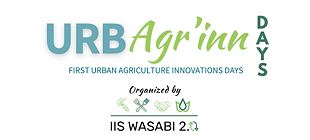
.png)
Uncovering circular strategies to maximize local resources in urban agriculture
This article was written following the presentation by Verónica Arcas Pilz during the URBAGR’INN DAYS – First Urban Agriculture Innovations Days. Her contribution underscores the importance of coupling technical assessment tools like LCA with strategic thinking on circular resource use.
In recent years, the concept of circularity has increasingly been associated with urban agriculture, emphasizing the sector’s potential to integrate waste valorization strategies. The presentation by Veronica Arcas Pilz during the URBAGR’INN Days 2025 offered a valuable contribution to this discussion, focusing on the environmental assessment of resource flows in urban agriculture, particularly through the lens of Life Cycle Analysis (LCA).
The interest in recovering nutrients and materials from urban and agricultural waste streams is steadily growing. This trend is evident in the proliferation of European and international research projects such as Fertilecity, ReNu2Farm, BINAFET, and Focuse, as well as in the rise of innovative start-ups like Ostara Nutrient Recovery Technologies and Vuna GmbH. These initiatives align closely with the Sustainable Development Goals (SDGs), particularly responsible consumption and production (SDG 12), and support the European Green Deal's ambition to “mobilize industries for a clean and circular economy.”
While the idea of valorizing waste in agriculture is not new — animal husbandry by-products and food waste have long been repurposed as compost or feed — the recent shift lies in targeting urban waste as a resource. This approach aims not only to reduce environmental impact but also to enhance local self-sufficiency by using materials sourced within the city. Despite significant progress in nutrient recovery techniques, there remains a research gap regarding the real-world application and environmental benefits of such practices, particularly in urban contexts.
As part of the Resource-Smart Farming thematic track, Veronica Arcas Pilz proposed a symbiotic model between urban ecosystems and agriculture. This model emulates natural flows to recover nutrients, materials, heat, and energy from urban waste streams, redirecting them into productive use for urban agriculture. Such integration could improve waste management strategies while reducing reliance on external or imported inputs, thereby minimizing the environmental footprint of urban and peri-urban agricultural systems.
This circular principle has broader implications beyond urban farmers. Existing industries that generate valuable by-products, municipal waste management authorities, and civil society at large can all play a role in rethinking waste as a resource for local food production.
In her presentation, Veronica introduced Life Cycle Analysis (LCA) as a method to both quantify available resources and assess the impacts of their integration into agricultural systems. She emphasized that LCA is a powerful tool to evaluate the environmental performance of circular strategies. However, she also highlighted the complexity involved in applying it. During the interactive workshop she facilitated, participants were invited to perform the first step of an LCA: compartmentalizing the needs and resources of a farm. This exercise revealed the non-trivial nature of defining and organizing system boundaries, inputs, and outputs, even at a preliminary stage — a clear indication of the methodological rigor required to effectively assess circular strategies in urban agriculture.
